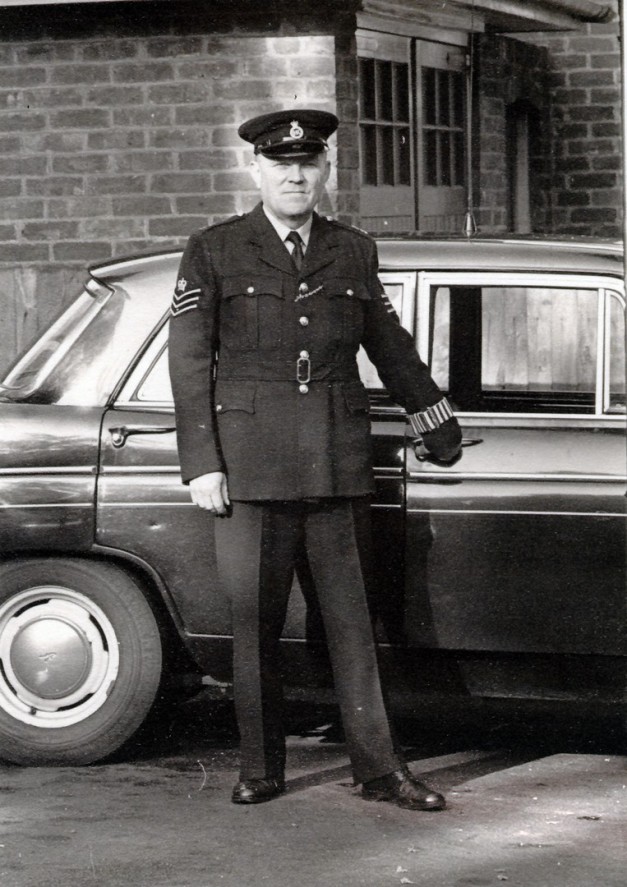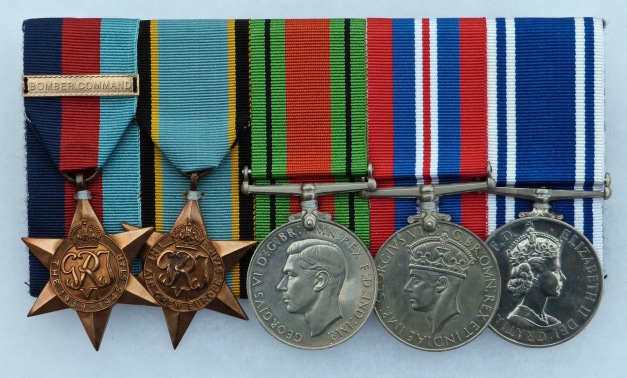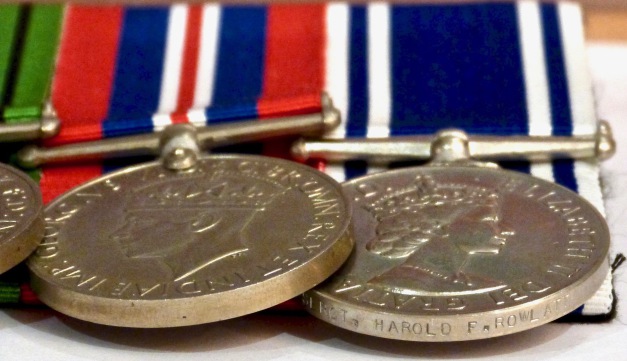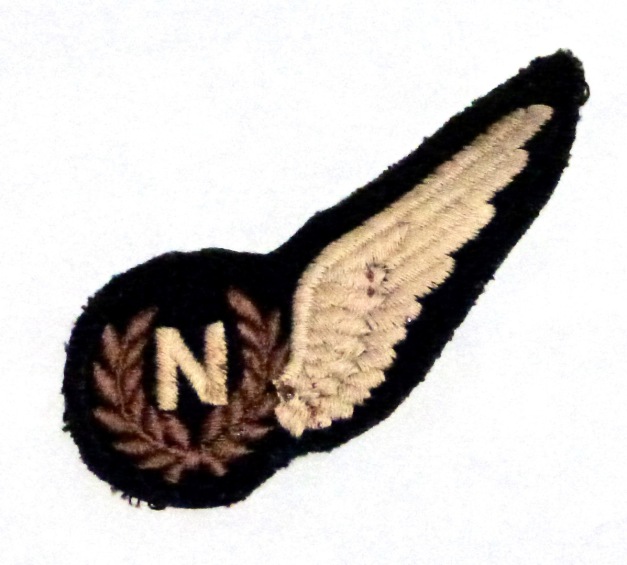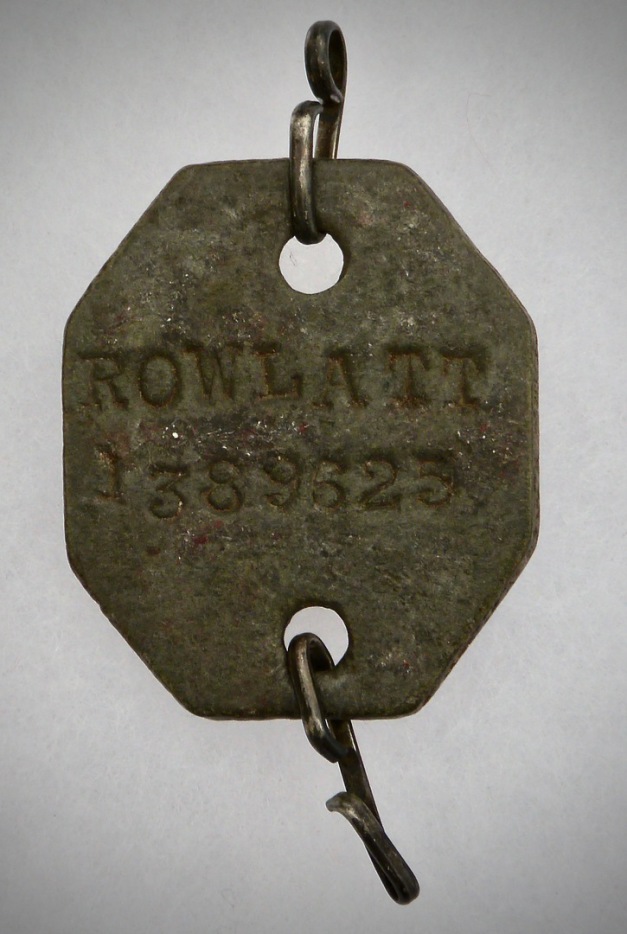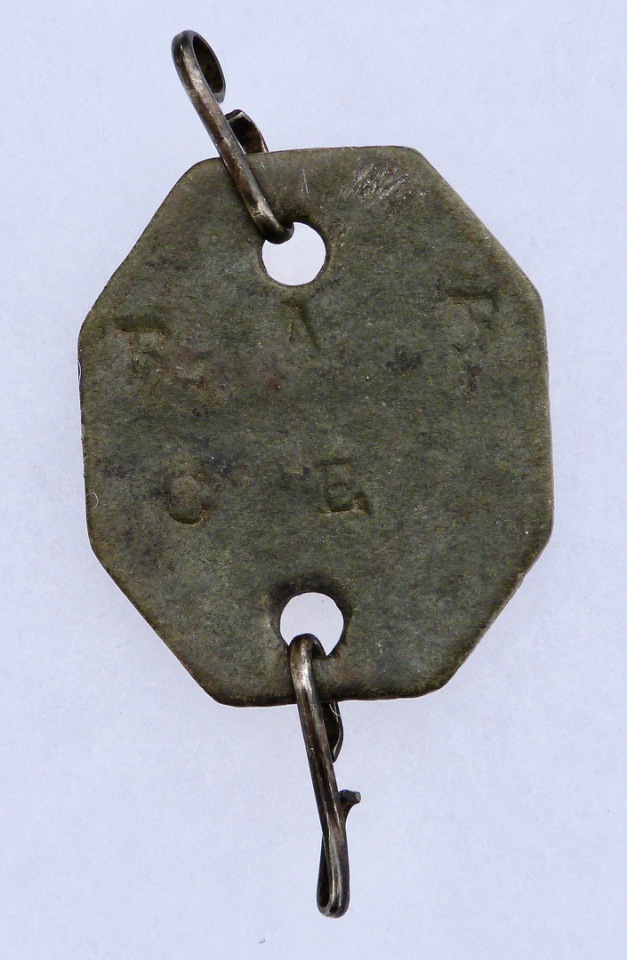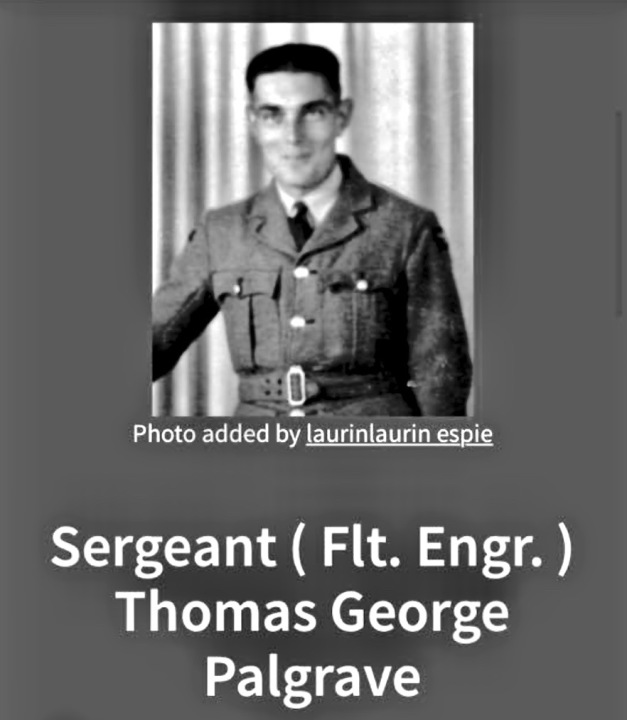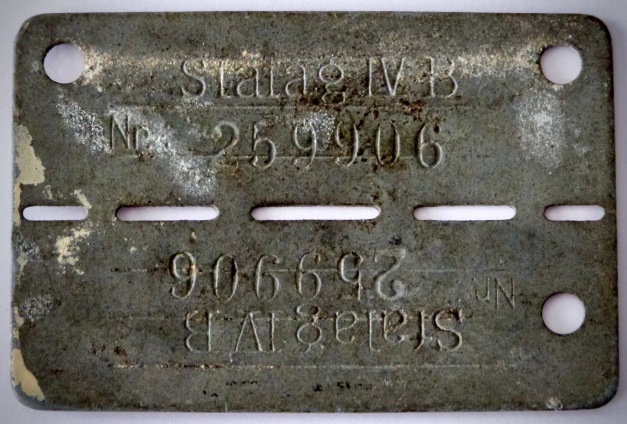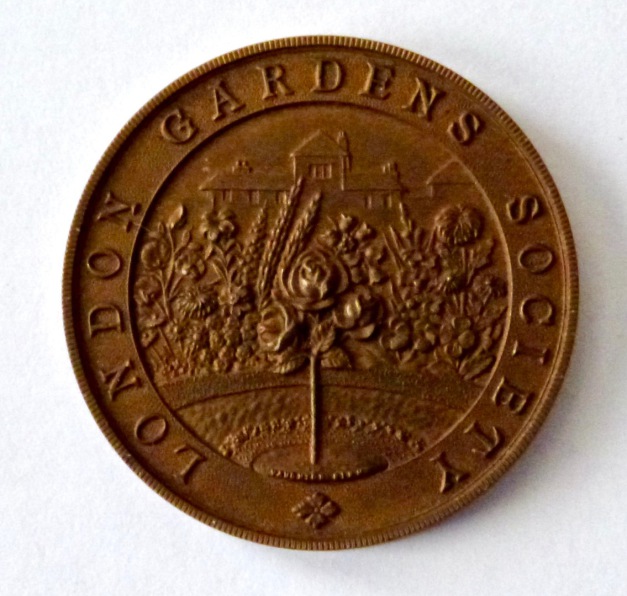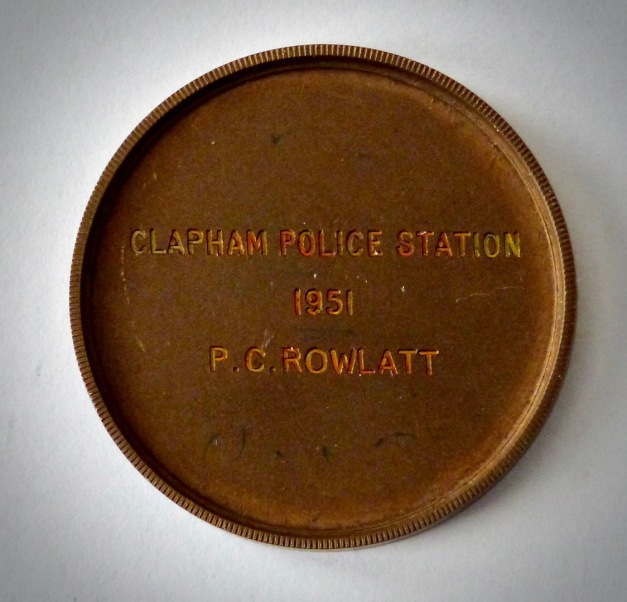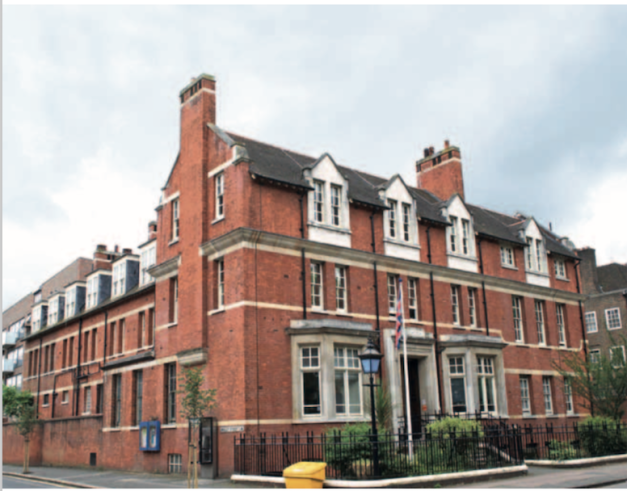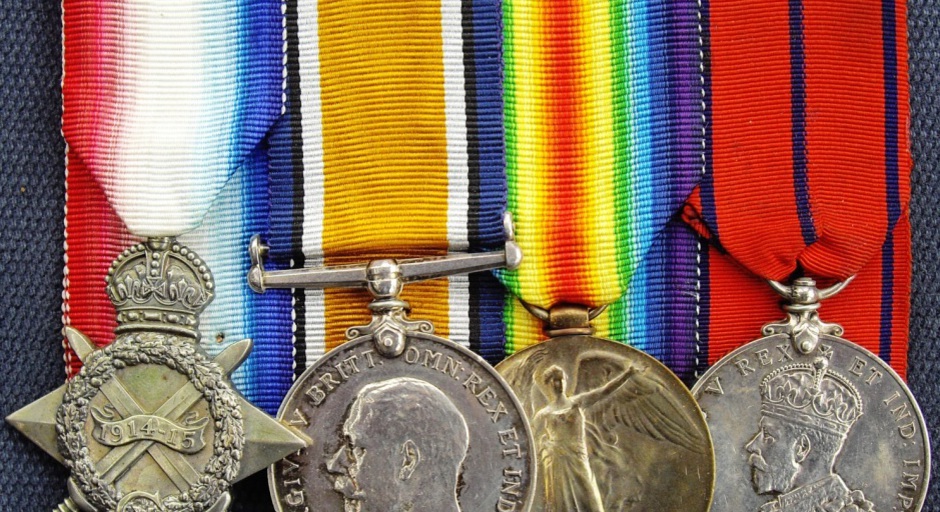
Metropolitan Police - SPS 3 P Harold Frederick Rowlatt
The medals are from L - R, The 1939 - 1945 Star with Bomber Command Clasp, The Aircrew Europe Star, The Defence Medal, The 1939 - 1945 War Medal, The Police Long Service & Good Conduct Medal, (EIIR - 1960).
Introduction
Metropolitan Police
Station Police Sergeant (SPS) 3 P Harold Frederick Rowlatt
The 1939 – 1945 Star (Clasp ‘Bomber Command’)
The Aircrew Europe Star
The Defence Medal
The 1939 – 1945 War Medal
The Police Long Service & Good Conduct Medal (EIIR – 1960)
Introduction
This interesting Royal Air Force (RAF) Bomber Command and Metropolitan Police group caught my eye in an online auction in London. I have never owned such modern medals and it has been a steep learning curve in areas of research I was previously unfamiliar with. I have tried to record as many details of Sergeant Rowlatt’s RAF and police careers as possible. I am indebted to Harold’s daughter Lesley for the picture of him as a Station Sergeant between 1962 and 1968 when he was stationed first at Lee Road, then Bromley.
Harold Frederick Rowlatt was born on 19 September,1915 in Corby in Northamptonshire. His father was Alfred Rowlatt, an Ironstone Weigher and Louise Margaret Perkins or Rowlatt. His parents were married on 2 May 1914 at St John’s Parish Church, Tottenham in London. [i]
His previous occupation was a Time Clerk when he joined the Metropolitan Police as Police Constable (PC) 250 L, (Warrant No. 127046) at Clapham (LM) in 1938.
He enlisted in the Royal Air Force Volunteer Reserve (RAFVR) on 1 May 1941 and served as a Navigator in Bomber Command. In 1942 at Battersea in London, he married Betty Joan Kenwright, (23), a General Post Office (GPO) Telephonist.
Harold had completed 17 missions over occupied Europe when on the 18th, his Halifax Mk II aircraft, JX 173 “N”, was shot down near Hannover in 1943. The pilot and two of the crew were killed; Rowlatt and three others survived, and he was a prisoner of war in Stalag IVB Muhlberg on Elbe until early 1945 when he was repatriated. The couple’s daughter was born in 1946. He continued to serve in the RAFVR until 1946 when he rejoined the Metropolitan Police.
After the war, Harold continued to serve as a PC in Clapham, and it was here that he was awarded a bronze medal of the London Gardens Society for his efforts in maintaining the small garden at the entrance to Clapham Police Station. In 1954, Harold was promoted to Police Sergeant (PS) and transferred to Carter Street (MD) as PS 65 M and in 1962, to Station Police Sergeant (SPS 3 P at Lee Road (PE) and in 1965 at Bromley (PR).
Harold Rowlatt retired on pension in July 1968. I have no information on what he did after retirement, but the couple were still living in south London at that time.
Around 2003, the couple were living in Devon near their daughter and her husband.
Betty Joan Kenwright or Rowlatt died in Devon in 2004. Harold Frederick Rowlatt died there the following year. Their daughter registered their deaths.
What follows are details of some family history, Harold Frederick Rowlatt’s life in the police, the RAFVR, including his time as a POW, most of which, I found in official documents. The information is recorded in chronological order and a bibliography is included at the end.
[i]Ancestry.co.uk
Register of Births in Kettering, Northamptonshire, 1915
Harold Frederick Rowlatt was born on 19 September 1915 at Corby, Northamptonshire. His father was Alfred Rowlatt, and Ironstone Labourer and his mother, Louise Margaret Rowlatt, formerly Perkins. His mother registered his birth. [i]
Metropolitan Police Orders, 1938
Police Orders of Monday 18 July 1939 on page 577, Item 3, ‘Candidates Joined the force this day’, record that Harold Frederick Rowlatt (then 24 years), joined the force with Warrant Number 73/127046 and the collar number L.250. [ii] His previous occupation was a ‘Time Clerk’.
Register of England & Wales, 1939
The Register of England and Wales shows that among those living at the Police Station and Section House, 51 Union Grove, Wandsworth in London was Harold F. Rowlatt, born 19 September 1915 and a Police Constable. [iii] This is the address of Clapham Police Station.
Enlistment in the Royal Air Force Volunteer Reserve (RAFVR), 1941
It is highly likely that Harold Rowlatt enlisted in the RAFVR at
the Euston Reserve,
No. 13 Aviation Candidate Selection Board, Euston House, Eversholt Street, London NW1 on 1 May 1941. He was placed on Reserve until he reported for training on 15 December 1941. [1]
Metropolitan Police Orders, 1941
Police Orders of Friday, 5 December 1941 on page 847, Item 3, ‘Navy, Army and Air Force’ record that,
“The undermentioned officers, joining the Royal air Force, as special cases with the Commissioner’s consent, under the provisions of the Police and Firemen (War Service) Act, 1939, will be retained on the Strength of the Force as supernumeries “off pay” and are to be shown on the Weekly States. They will receive pay to 14 December:-
F PC 494-126636 Patrick
H PC 752-125897 Pratt
L PC 250-127046 Rowlatt”[iv]
[1]In his ‘Liberation Questionnaire’, Harold Rowlatt gives his date of enlistment as 1 May 1941. That was the day he enlisted in the RAFVR. 15 December 1941 was the date he was called for training.
Royal Air Force Volunteer Reserve December 1942 - June 1943
No. 1 Air Crew Reception Centre (1 ACRC)
Harold reported to 1 ACRC on 15 December 1942 and began his basic training as Aircraftsman Class II, No. 1389625. Like many, he was recommended for pilot training and after basic training, trained as a pilot until 20 May 1942 when he was posted to No 50 (Training) Group.He was remustered as a Navigator on 12 June that year.
Register of Marriages, Battersea, London, 1942
On 18 April 1942 at the Register Office in Battersea, London, Harold Frederick Rowlatt, (26), at present an Aircraftsman Class II No. 1389625, RAFVR but also a Metropolitan Police Constable of 34 Lavender Gardens, Battersea, and son of Alfred Rowlatt, Platelayer, married Betty Joan Kenwright, (23), a telephonist (GPO) also of 34 Lavender Gardens, Battersea and daughter of Percy John Kenwright, Builder.
The witness is Percy John Kenwright, a Master Builder and Betty’s father.
Service in the RAFVR between 1941 -1943
Due to the kind assistance of Harold’s daughter, I was able to access his RAF personnel record. What follows is a record of his service from joining up, being trained as aircrew, first as a pilot, then a navigator and a summary of some of his experiences with 102 (Ceylon) Squadron (Sqn) flying Halifax II bombers from RAF Pocklington in Yorkshire as part of No 4 Group, Bomber Command.
Basic Training
Harold Rowlatt was posted to No. 1 Empire Air Navigation School, Cranage, Cheshire on 20 June 1942. Two months later, he was posted to No. 5 Air Observers School, Winnipeg, Manitoba, Canada on 28 August 1942. He was promoted to Sergeant and awarded his Navigator’s brevet at the end of the course on 13 December 1942.
28 Operational Training Unit (28 OTU)
Harold was transferred to 28 Operational Training Unit at Wymeswold in Leicestershire from 29 December 1942 to be trained on two-engine bomber aircraft. It was during this period that he ‘crewed-up’. The accepted method was for twenty pilots, 20 navigators, 20 bomb-aimers, twenty wireless operators and forty gunners to assemble in a hall and be left to their own devices. The end result was twenty self-selected crews. Harold’s crew were Sgt. Ronald Ellis, (Pilot), Sgt. Harold Frederick Rowlatt, (Navigator), Sgt. Woolerton, (Wireless Operator), Sgt. Buchanan, (Air Gunner, Sgt. Sydney Williams, (Air Gunner), Sgt. Thomas George Palgrave, (Engineer), Sgt. Mason, (Bomb Aimer).
1658 Heavy Conversion Unit (1658 HCU)
On 24 May 1943, Harold’s crew were transferred to 1658 Heavy Conversion Unit at RAF Riccall in Yorkshire. It was here that crews converted to four engine heavy bombers, in Harold’s case, the Halifax bomber. The purpose of the HCU was to allow the crews to familiarise themselves with every piece of equipment aboard the aircraft and to become skilled in their efficient use.
Having completed their conversion course, the crew were posted to 102 (Ceylon) Squadron flying out of RAF Pocklington in Yorkshire.
102 (Ceylon) Squadron, Royal Air Force, June 1943
The Operations Record book for 102 (Ceylon) Squadron RAF for 23 June 1943, under ‘Summary of Events’ records postings in and out of the squadron during that month. The names of Harold Rowlatt and his fellow crew members were recorded under the heading ‘Postings to for flying duties N.C.Os.’ [i]
These were to remain Harold Rowlatt’s fellow aircrew and their fate inextricably linked for the rest of their time during the war.
[i]AIR/27/809/11 102 Squadron, RAF, Summary of events, June 1943.
102 (Ceylon) Squadron Harold Rowlatt's RAF missions July 1943
102 Squadron, Royal Air Force, July 1943
The squadron Operations Record Book (ORB) records that between 1 and 12 July, the weather was very poor, and they were only able to undertake 2 missions, to Cologne and Gelsenkirchen, a coal mining area. During the rest of the month, the squadron flew another 5 missions.
Disaster struck on Tuesday 13 July when 23 aircraft were detailed to attack Aachen. One aircraft, Halifax ‘JD 297’ “Q” failed to return. The event is described in the Squadron Summary of Events as follows:
“The loss of the Squadron Commander (W/C H.R. Coventry) with the loss of his Navigator (F/L F. E. King) and Gunnery Leader (F/L G. F. Hogg)was the heaviest blow the Squadron has suffered for some time. All three were deservedly popular and thoroughly conversant with their job. W/C Coventry had only been the C.O. since the 12thApril 1943 having been posted supernumery on the 18thMarch. In his short time as Squadron Commander, he has impressed everyone by his complete devotion to his work , his general personality and invariable courtesy to all. While it is devoutly to be hoped that he has not died for the Squadron, it is certain that he lived for it.” [i]
See the entry for 13 July 1943 below.
Harold Rowlatt’s Missions in Halifax Mk. II, 102 Squadron, July 1943
(Rowlatt’s aircraft is in the left column)
|
Aircraft
|
Date |
Crew |
Target |
Remarks |
|
JD 169 “J” |
3 July, 1943 |
As above |
Cologne |
653 bombers were despatched for another raid on Koln, the bombing attack being carried out between 01.13 and 02.17 hours.
In support of the Main Force raid, 20 Fighter Command aircraft patrolled the Nachtjagd (Luftwaffe night fighter force) airfields along the bomber’s routes.
30 ‘heavies’ (heavy bombers) failed to return, one of which was from 102 Sqn, Halifax BB428 (Q) shot down at 01.46 near Winterscheid. The crew were:
BB 428 (Q) F/Sgt Jenkins. Killed P/Officer Hodgson. Killed Sgt Peck. Killed Sgt McConnell. Killed Sgt Watson. POW Sgt Galloway. POW Sgt Garlick. Killed
During the course of the night’s actions, Nachtjager intercepted an estimated 59 Bomber Command Aircraft. 41 of these interceptions developed into a combat, resulting in 29 Abschusse (a confirmed shooting down or kill) and four aircraft returning to the UK with fighter damage, three being badly shot up. Flak was credited with six kills, another 64 aircraft being damaged by flak, mainly while flying through a heavy barrage on the run up to, and over the target. [ii]
|
|
DT 845 “V” |
9 July, 1943 |
As above |
Gelsenkirchen |
422 aircraft bombed between 01.09 and 01.49 hours. Intruder activity by Fighter Command was limited at five sorties. Seven Halifaxes, one of which, BB249, (Z) was from 102 Sqn, and five Lancasters went missing. [iii]
The missing crew were:
BB249 (Z) F/Sgt Fraser. Killed Sgt Stockton. POW F/Sgt Mansell. Killed Sgt Glass. Killed Sgt Edwards. POW Sgt Morse. Killed Sgt Brand. POW
|
|
JD 111 “P” |
13 July, 1943 |
As above |
Aachen |
374 aircraft, mainly Halifaxes, raided Aachen in the final sortie of the Battle of the Ruhr. Bombing between 01.41 and 02.20 hours, the attack devastated large parts of Aachen.
40 Fighter Command intruders supported the raid. Main force losses amounted to 15 Halifaxes, two of which were from 102 Sqn, JD297 shot down at 02.19 and JB 894, 2 Lancasters, 2 Wellingtons and a Stirling. Two heavy bombers returned to England with fighter damage, one being badly shot up. [iv]
The missing 102 Sqn crews were:
JD 297 (Q) W/Commander Coventry, Killed (C.O. 102 Sqn). F/Lieutenant King, Killed (Navigation Leader). F/Lieutenant Hogg, Killed (Gunnery Leader). Sgt Brown. Killed Sgt Hardy. Killed Sgt Pine-Coffin. Killed F/Officer Reid. Killed
JB 894 (X) Sgt Amos. Killed Sgt Douthwaite. Killed Sgt Fradley. Killed Sgt Brown. POW Sgt Raw. Killed Sgt J. Smith. Killed Sgt W. Smith. Killed
|
|
JD 165 “H” |
15 July, 1943 |
As above |
Montbeliard |
165 Halifaxes penetrated deep into eastern France to the Peugeot motor factory at Montbeliard. The bombs were dropped between 01.45 and 02.11 hours and five aircraft lost. [v]
|
|
JB 844 “N” |
24 July, 1943 |
As above |
Hamburg |
791 bombers were dispatched to attack the port city of Hamburg between 00.51 and 01.56 hours. 12 aircraft were lost, one from 102 Sqn, DB308 (X) at 01.20 near Lengenbostel. [vi]
The missing crew were:
F/Lieutenant Bakewell. Killed F/Sgt Cowin. Killed P/Officer Smith. POW F/Sgt Page. Killed Sgt Edwards. Killed Sgt Wood. Killed Sgt Swinton. Killed P/Officer Hill. Killed
|
|
JB 844 “N” |
25 July, 1943 |
As above |
Essen |
705 aircraft successfully attacked Essen’s industrial areas between 00.28 and 01.15 hours. 26 bombers were lost, one from 102 Sqn. [vii]
The missing crew were:
JD 169 (J) Sgt Whitehouse. Killed P/Officer Smith. Killed Sgt Brown. Killed Sgt Evans. Killed F/Sgt Turner. Killed Sgt Spencer. Killed F/Lieutenant Moon. Killed
|
|
JB 844 “N” |
27 July, 1943 |
As above |
Hamburg |
787 aircraft attacked Hamburg on this night between 00.55 and 01.46 hours dropping 2,326 tons of bombs. 17 aircraft failed to return, two from 102 Sqn, JD150 and JB864. [viii] The missing crews were:
JD 150 (A) Sgt Brown. Killed P/Officer Hitchcock. Killed Sgt Rooke. Killed Sgt Gough. Killed Sgt Sinclair. Killed Sgt Tyler. Killed F/Officer Allison. Killed
JB 864 (B) F/Officer Clarke. Killed Sgt Thorne. POW Sgt Bailey. Killed Sgt Harrison. Killed P/Officer Slater. Killed Sgt Bartle. Killed F/Officer. POW
|
|
JB 844 “N” |
29 July, 1943 |
As above |
Hamburg |
777 bombers took part in this raid between the hours of 00.32 and 01.52. 28 bombers were lost, two from 102 Sqn, HR711 and W7883. [ix]
The missing crews were:
HR 711 (C) Sgt Gaston. Killed Sgt Ball. Killed Sgt Williams. Killed Sgt Brown. Killed Sgt Veraas. Killed Sgt Yarwood. Killed Sgt Cocking. Killed
W 7883 (R) F/Sgt MacQuarie. Killed Sgt Whitley. Killed Sgt Wright. Killed Sgt Trehennan. Killed Sgt Morgan. Killed Sgt Woodroff. Killed F/Officer Williams. Killed
Harold Rowlatt’s aircraft, was the subject of an Air Combat Report for an attack upon it on the return journey from Hamburg in which the tail wheel and flaps were damaged. Please see AIR/50/205 below.
|
Air Combat Report 29/30 July 1943
The following is taken from an Air Combat Report (ACR) dated 1 August 1943 and entitled “Halifax “N” V J.U.88”.
ACR gave a short report of any air to air combat that bomber crews experienced on missions. They usually contain details of times, positions, course, the type of enemy aircraft, the action taken, by whom and the crew involved in dealing with the incident.
The report usually ends with a note of the training background of the crew involved, in this case, the Rear Gunner, Sgt. Buchanan and the Pilot, Sgt. Ellis.
“The following is a report of a combat entered into by 102 Squadron Halifax “N” JB 844 on the night of 29/30thJuly 1943 whilst attacking Hamburg.
The combat was at 5420 N – 0659 E (just after leaving the coast on the way home) Height 16,000 ft. Speed 175 ind. Course 303 M. Time 0136.
The visibility was good. There was no moon, but the Northern Lights were on the starboard bow, when Monica* began to pip – a JU 88 was the seen by the rear gunner making a diving attack from about 20 degrees port of astern.
The pilot on hearing Monica started a slight diving turn into the dark part of the sky (port) – but the E/A was able to follow. Thereupon the rear gunner told the pilot to corkscrew and then at the same time opened fire with a two second burst. The trace was seen to go in the front of the fighter which then broke away to the port quarter down as the Halifax was on the starboard climb of the corkscrew. The range at breakaway was approximately 300 yards and the fighter was not seen again. No strikes were observed on the fighter and there was no damage to our aircraft.
The M. U. gunner was unable to bring his guns to bear.
Rear Gunner – 1351233 Sgt. Buchanan. No. 7 A. G. S.[ii]
28 O.T.U [iii]
1658 C.U.
Driffield N. V. Course
Pilot - 1435345 Sgt. Ellis No. 28 O.T.U.
1658 C.U.
Signed. Walters F/Lt.
Gunnery Leader
No. 102 Squadron R.A.F.” [iv]
* ‘Monica’ was an airborne radar system. A highly successful tactic used by German night fighters was to follow the bombers on the homeward journey and using their own radar to zero in on their target, engage them from below and destroy or damage them. The following is taken from the testimony of Henry Wagner, like Harold Rowlatt, a Halifax Navigator in Bomber Command shot down and captured a year after him:
“…the Germans hit upon the most effective way of dealing with a bomber once it was found and identified; so simple, it is amazing it was never thought of before, and it was a long time before anyone twigged what was happening. Early in the war, some aircraft, notably Wellingtons, had a turret underneath, but the fitting of these was discontinued, so there was no protection from below. Two tail warning and downward-looking radars, ‘Monica’ and ‘Fishpond’, were fitted, but these were removed when it was found that the Germans were homing on to them. Realising they had a clear field from underneath, a German fighter, invisible against the dark background below, would gradually increase its height until it was some 150 to 200 feet below the bomber, with the bomber silhouetted against the lighter sky above and its exhaust flames clearly visible. On the same course and at the same speed the bomber was a sitting duck. German twin-engined fighters had a cannon sticking out through the roof, known as ‘Schrage musik’, and the gunner could let rip with a no deflection shot. They always aimed for the starboard wing tanks, not the fuselage where there would be a risk of detonating explosives on board. Having thus set the aircraft on fire the enemy departed in search of other prey. They carried no tracer among their ammunition, so that there was no give-away, and a bomber seemed to others around just to catch fire for no apparent reason.” [v]
[i]AIR/27/809/13, 102 Squadron, RAF, Record of events, July 1943.
[ii]No. 7 Air Gunnery School, RAF Stormy Down, near Pyle, Bridgend, Wales.
[iii]No. 28 Operational Training Unit, Wymeswold, Leicestershire.
[iv]AIR/50/205, Air Combat Report, 102 Squadron RAF, 29/30 July 1943.
[v]Last of the Kriegies’ Darlow, S. et al, pp 165 -166, Fighting High Ltd., 2017.
[i]AIR/27/809/13, 102 Squadron, RAF, Record of events, July 1943.
[ii]Nachtjagd Combat Archive, 1943, Part 2, page 19. Red Kite, (2018).
[iii]Nachtjagd Combat Archive, 1943, Part 2, page 24. Red Kite, (2018).
[iv]Nachtjagd Combat Archive, 1943, Part 2, page 27. Red Kite, (2018).
[v]Nachtjagd Combat Archive, 1943, Part 2, page 30. Red Kite, (2018).
[vi]Nachtjagd Combat Archive, 1943, Part 2, page 34. Red Kite, (2018).
[vii]Nachtjagd Combat Archive, 1943, Part 2, page 39. Red Kite, (2018).
[viii]Nachtjagd Combat Archive, 1943, Part 2, page 43. Red Kite, (2018).
[ix]Nachtjagd Combat Archive, 1943, Part 2, page 46. Red Kite, (2018).
102 (Ceylon) Squadron Harold Rowlatt's RAF missions August - September 1943
Harold Rowlatt’s Missions in Halifax Mk. II, 102 Squadron, August 1943
|
Aircraft |
Date |
Crew |
Target |
Remarks
|
|
JD 307 “Q” |
22 August, 1943 |
As above |
Leverkusen |
462 aircraft were dispatched to bomb the target between 00.33 and 00.50 hours. Five aircraft failed to return, one of which, JD378, was from 102 Sqn. [i]
The missing crew were:
JD 378 (C) S/Leader Jackson. POW F/Officer Booth. POW Sgt Kaye. POW Sgt Dolan. POW Sgt Haynes. POW Sgt Williams. Killed Sgt Vernon. POW
|
Harold Rowlatt’s Missions in Halifax Mk. II, 102 Squadron, September 1943
|
Aircraft
|
Date |
Crew |
Target |
Remarks |
|
JB 305 “B” |
15 September, 1943 |
As above |
Montbeliard (Montlucon?) |
369 heavy bombers (including 5 American B-17s attacked the Dunlop Rubber factory at Montlucon in central France dropping their bombs between 00.24 and 01.21 hours (CET). Three aircraft were lost. [iii]
|
|
HR 927“N” |
16 September, 1943 |
As above |
Modane |
340 aircraft made the long haul to attack the main railway connection between France and Italy situated at Modane in south east France. One aircraft was lost. [iv] |
|
HR 927 “N” |
22 September, 1943 |
As above |
Hannover |
711 aircraft bombed targets in the city between 22.16 and 23.15 hours (CET). 25 bombers were lost, HX154, from 102 Sqn. [v] The missing crew were:
HX 154 (K) F/Officer Hanby. POW P/Officer Williams. POW Sgt Taylor. POW Sgt Maund. POW F/Sgt Windmill. POW Sgt Edlin. POW Sgt Anderton. POW
|
|
HR 927 “N” |
23 September, 1943 |
As above |
Mannheim |
628 RAF ‘heavies’ plus five B-17s of the 8thUnited States Army Air Force (USAAF) were due over their targets in Mannheim between 22.38 and 23.20 hours (CET). 32 bombers were lost that night. [vi]
|
|
HR 927 “N” |
27 September, 1943 |
As above |
Hannover* |
678 aircraft attacked targets in Hannover between 22.54 and 23.29 hours (CET). 38 bombers were lost, including a Luftwaffe claim for Rowlatt’s aircraft, HR 927 “N”. [vii]
See the Air Combat Report AIR 50/205 below for details of the encounter.
|
*Attacked by enemy Junkers JU 88 over target. See Combat Report below.
Air Combat Report (ACR) 27/28 September 1943
The following is taken from an Air Combat Report dated 30 September 1943 and entitled “Halifax II – HR 927 “N” V J.U.88”.Items 1 and 2 of the ACR record HR 927s position over Hannover. The next paragraph states:
“Coned**in searchlights over target. JU 88 sighted on starboard quarter down. Range 500 yards by rear gunner who opened fire. At the same time, M/U/G* reported JU 88 on the port beam level, range 400 – 500 yards. Combat manoeuvre taken, corkscrew to port. R/G immediately reported JU dead astern slightly up, range 400 yards. He opened fire and gave a 7 second burst also the M/U/G opened fire and gave a 5 second burst. Hits were observed on JU 88s port engine. JU 88 broke away port quarter down with smoke coming from his port engine. (Claimed as destroyed. Confirmed by crew).
After leaving the target were fired at by an unseen aircraft.
DAMAGE TO HALIFAX EXTENSIVE. AWAITING A REPORT AS IT LANDED AWAY FROM BASE.
Pilot – F/Sgt Ellis
R/G – 1351235 Sgt. Buchanan. 7 A.G.S. Stormy Down
28 O.T.U. Wymeswold
1658 C.U. Riccall
M/U/G/ - 1452582 Sgt. Williams. 7 A.G.S. Stormy Down
28 O.T.U. Wymeswold
1658 C.U.”
*M/U/G = Mid Upper Gunner. [ix]
** Coned = Caught in a group of radar-controlled searchlights which enabled Luftwaffe anti-aircraft gunners to ‘lock on’ to the stricken aircraft.
[i]Nachtjagd Combat Archive, 1943, Part 2, page 75. Red Kite, (2018).
[ii]AIR/27/809/16, 102 Squadron RAF, Record of Events, August 1943.
[iii]Nachtjagd Combat Archive, 1943, Part 2, page 120. Red Kite, (2018).
[iv]Nachtjagd Combat Archive, 1943, Part 2, page 121. Red Kite, (2018).
[v]Nachtjagd Combat Archive, 1943, Part 2, page 127. Red Kite, (2018).
[vi]Nachtjagd Combat Archive, 1943, Part 3, page 4. Red Kite, (2018).
[vii]Nachtjagd Combat Archive, 1943, Part 3, page 14. Red Kite, (2018).
[viii]AIR/27/809/18, 102 Squadron RAF, Record of Events, August 1943.
[ix]AIR/50/205, Air Combat Report, 102 Squadron RAF, 27/28 September 1943.
102 (Ceylon) Squadron Harold Rowlatt's RAF missions October 1943
Harold Rowlatt’s Missions in Halifax Mk. II, 102 Squadron, October 1943
|
Aircraft
|
Date |
Crew |
Target |
Remarks |
|
HX 158 "O" |
2 October, 1943 | As above | Gardening |
The ORB entry for HX 158 "O" on 2 October states "Dropped radishes 6000 ft , 206 degrees M, 155 LAS. 3/10 Cloud below 600 ft. Good visibility. Visual pin point as ordered and D.R. run 2.5 minutes to dropping point. Checked with H2S equipment."
|
|
HX 158 "O" |
3 October, 1943 | As above | Kassel |
Between 22.08 and 22.40 hours (CET), Kassel was the target for 547 bombers, 24 of which were lost.
|
|
HX 158 "O" |
7 October, 1943 | As above | Gardening |
The entry for 7 October simply states "Mines dropped as ordered."
|
| HR 927 "N" | 8 October, 1943 | As above | Hannover |
Bomber Command mounted two operations that night, to Hannover and Bremen. 102 Squadron took part in the Hannover raid, its ten aircraft part of a force of 504 bombers.
Luftwaffe 8thFlak [1]Division reports indicate that:
“102 Sqn Halifax HX173 was coned by 3/ Flakscheinw.[1]Abt.498, 3./ Flakscheinw. Abt.138 and 1. and 2. Flakscheinw. Abt 238, hit by 1. and 2./schw. Flak Abt 606, 2. and 3./schw. Flak Abt 262 (0), 1./schw. Flak Abt. 390 and 1./schw. Flak Abt. 542, crashed nr. Lichtenhorst at 01.30 hrs.”[i]
This indicates that HX173 was caught in the searchlights of 3 – 4 Flakscheinwerfer, hit by 4 -6 Anti-Aircraft Artillery (AAA) explosive shells and crashed near Lichtenhorst about 01.30 (CET).
The missing crew were:
HR 927 (N) F/Sgt Ellis. Killed Sgt Rowlatt. POW Sgt Woolerton. POW Sgt Buchanan. POW Sgt Williams. Killed Sgt Mason. POW Sgt Palgrave. Killed
[1]Flakscheinwerfer = Flak Searchlight.
[i]Nachtjagd Combat Archive, 1943, Part 3, page 35. Red Kite, (2018).
[1]‘Flak’ is a contraction of the German word FLugseugabwehrkanone meaning aircraft defence cannon, the original purpose of the weapon, the 8.8.cm German anti-aircraft and anti-tank artillery. In English, ‘flak’ became a generic term for ground anti-aircraft fire.
|
What Happened to Halifax II HR 927 “N”?
It is believed the aircraft crashed about 0120 on 9 October 1943, 2 Km from Lichtenhorst, 7 Km north of Stiembke, about 22 Km north-west of Hannover, Germany.
Of those on board, Flight Sergeant Ronald Ellis, (Pilot), Sergeant Thomas George Palgrave, (Flight Engineer) and Sergeant Sydney Williams, (Air Gunner) died in, or shortly after, the crash. They were initially buried in Lichtenhorst on 10 October but later reinterred in the Hannover War Cemetery. They are buried together in Plot V, Row B. The record of RAF War Dead describes the men as follows:
“ELLIS, Pilot Offr. (Pilot), 159481. RAF (VR). 102 Sqdn. 9thOctober 1943, Age 21. Son of Frederick Valentine Ellis and Fanny Ellis of Hull. 5. B. 1.”
PALGRAVE, Sgt. (Flt. Engr.) Thomas George, 1167098. RAF (VR). 102 Sqdn. 9thOctober 1943. Age 27. Son of Albert and Beatrice Palgrave, husband of Elizabeth Palgrave, of East Tuddenham, Norfolk. 5. B. 2.”
WILLIAMS, Sgt. (Air Gnr.) Sydney, 1452582. RAF (VR). 102 Sqdn. 9thOctober 1943. 5. B. 3.”
Sergeants H. F. Rowlatt, (Navigator), J. Mason, (Bomb Aimer, J. Woolerton, (Wireless operator) and J. McN. Buchanan became Prisoners of War (PoW).
[i]Nachtjagd Combat Archive, 1943, Part 2, page 19. Red Kite, (2018).
[ii]Nachtjagd Combat Archive, 1943, Part 2, page 24. Red Kite, (2018).
[iii]Nachtjagd Combat Archive, 1943, Part 2, page 27. Red Kite, (2018).
[iv]Nachtjagd Combat Archive, 1943, Part 2, page 30. Red Kite, (2018).
[v]Nachtjagd Combat Archive, 1943, Part 2, page 34. Red Kite, (2018).
[vi]Nachtjagd Combat Archive, 1943, Part 2, page 39. Red Kite, (2018).
Life as a Prisoner of War in Stalag IVB Muhlberg on Elbe
Life as a Prisoner of War
By late 1943, RAF personnel were known in Germany as ‘Terrorflieger’( Terror flyer) and it was not unknown for downed aircrew to be summarily beaten, shot or lynched by the local German population with, or without, the complicity of local police or military authorities. Apart from the terror of being shot out of the sky and then descending into hostile territory by parachute, the prospect of capture, interrogation and imprisonment for the foreseeable future was the only certainty.
All RAF personnel captured were the responsibility of the Luftwaffe and the procedure following capture was the same experience for all. Solitary confinement for a short period at Dulag Luft 1 [1] during which they would be interrogated on their squadron, their missions, their colleagues and any other subject that might elicit some useful intelligence for the Germans. After a few days, most men were moved to a barrack room with other aircrew and would often be reunited with familiar faces from their service. After a few days, they were transferred to one of the Stalags, Stalag Lufts or Oflags [2]scattered about Germany and occupied Europe.
According to the questionnaire that Harold Rowlatt completed on his repatriation in 1945, He arrived at Stalag IVB Muhlberg on Elbe, Germany on 1 November 1943 and was there until liberated (by Soviet Union troops) on 23 April 1945.
His POW number was 259906 (See picture of POW ID disc). His date of enlistment is given as 1 May 1941 and his private address as 31 Parklands Road, Streatham in London. [i]
Sergeant J. Mason was also in Stalag IVB and his POW number was 259886. Sergeants J. Woolerton, POW number 259925 and J. McN. Buchanan, POW number 259853, were both held in Stalag Luft 3 near Sagan and Belaria, Poland. By April 1945, Sgt. J Woolerton was also in Stalag IVB in the same hut as Sgts. Rowlatt and Mason, 14A. Sergeant J Buchanan was in Hut 14B.[ii]
Life as a ‘Kriegie’ [3]
The following brief excerpt is taken from ‘Last of the Kriegies’ (2017), written by Steve Darlow in conjunction with five surviving RAF Bomber Command ‘Kriegies’. This particular section is taken from the notes made by Albert Gunn, also a former prisoner in Stalag IVB Muhlberg. His story gives an insight into some of the things Harold might have experienced.
“Stalag IVB was situated on the bank of the Elbe near a town called Muhlberg which was roughly thirty-five miles east from Leipzig, and the surrounding area was totally flat.The Stalag was a transit camp for working parties going out to work for the Germans, in theory on non-military jobs. As aircrew were all sergeants or above, we could not be used in this way. We should have been sent to a Luft camp, but the Germans seemed to be having trouble accommodating the numbers of aircrew being taken prisoner at that time. Being billeted mainly Army personnel, many of whom had been POWs for some time, led to quite a lot of friction; on average, as aircrew we were much younger, and the RAF discipline much slacker. At morning roll call we tended mess about, always being last to fall in and often the guards had to go into the huts to search out late sleepers, which of course, led to the whole parade at times being kept outdoors for long periods.
For the first six months of 1944 we had a fairly regular supply of Red Cross food parcels, which really were life savers. Issued usually on a Monday, we were also allocated fifty cigarettes each and, as Jack was the only smoker in our group, we twenty-five cigarettes each into a pool to buy additional food, and we each had twenty-five to spend, cigarettes being the only currency in the camp. Gerry and I usually bought a bar of chocolate, contained in the Canadian parcels, with our twenty-five, and when available a loaf of bread for fifty cigarettes came out of the pool to be shared by the three of us. The bread we tried to buy was smuggled into the camp by various people, mainly French prisoners who went out daily to work in Muhlberg. We also ‘bought’ from the Russians who were employed in the never-ending job of ‘pumping’ the dry cesspit toilets into a large barrel-shaped container on wheels and pulling it out into the surrounding country and spraying it over the fields as manure. They were known as ‘Sheissen Torpedoes’ and it was easy to realise that the camp could be located in the dark by the awful odour that surrounded it as the toilets were used by some 15,000 people…
The basic quota of food each day from the Germans was usually potatoes and either sauerkraut or a watery soup, with a portion of bread that varied at between five and ten people to a loaf. This was the basic black bread, which we understood contained a certain amount of sawdust and on eating could be believed. On rare occasions, there would be a ration of margarine, and a jam that was made from beetroot, but the memorable occasions would be an issue of cheese, which could be smelled even over the ‘Torpedoes’. It looked like Camembert but even at my hungriest, I couldn’t face it. The most popular item was millet, usually supplied about once a month, which looked like porridge and was quite filling. Our whole lives centred around food, and particularly when to eat -either as soon as it was given out and then go to bed hungry or wait until evening and go to bed with a full stomach. Usually the decision was controlled by when we could get access to a cooking pot and the times when the hot plates would have a fire under them, and fuel was always in short supply.
Gerry and I were fairly competent at cooking, but Jack was useless…
Life progressed through 1944 with, of course, the highlight being D-Day on 6 June and our thoughts turned to being home by Christmas. We were kept up to date with the news each evening as a radio operated in the camp for which the Germans were constantly on the hunt, fortunately without success…
The bulk of the RAF prisoners were in a small compound of eight huts…Living conditions deteriorated due to the bad winter weather, with poor food rations and the decline in delivery of Red Cross parcels but at least we were uplifted by the thought we would hopefully see the end of the war once the weather improved…
…we could hear artillery and small-arms fire around , and we woke on Monday 23 April , the Germans having left, to the sight of a lone horseman from the Red Army riding into camp, then turning round and riding off again, after giving instruction to the Russian POWs.” [iii]
Albert Gunn was repatriated on Saturday 26 May 1945.
Report by RAF Warrant Officer 1, R. Harding on Conditions at Stalag IVB dated 25 April 1045
‘Stalag IVB
Sir,
The above prisoner of war Camp is situated on the east bank of the river Elbe, approximately 35 miles north of Dresden. The Camp strength on 13thApril 1945 was approx. 18,000 P.O.W’s made up of approx. 9,800 Anglo-American forces. Several thousands of Russians, 1500 French and various numbers of Dutch, Poles, Serbs and Italians. The living conditions prior to the relief by the Russian forces was deplorable and the Detaining Power had imposed very serious ration cuts. Red Cross supplies were not forthcoming owing to transport difficulties and by April the average rations were 400 grammes of potatoes, a thin turnip soup and 200 grammes of bread. Many men suffered from the severe cold, which was made worse, when in February the small existing coal issue was stopped.
On Friday 13thApril, the German Camp Authorities handed over the control of the interior discipline to the British Officers, Lieut. Jessop assumed command of the whole camp. The RAF officers in the camp were recognised as Officers and F.O. Hunter took command of the RAF with W.O. Harding as W.O. in charge.
Exemplary discipline was shown by all British in the camp in the following. At 00.15 hours on 23rdApril 1945, the German Commandant informed the British that the Russians were in the vicinity, and that the guards were about to retreat from the camp. Immediate steps were taken to guard existing food supplies and the International Camp Police were ordered out. At 0730 hours the Camp was relieved by the Russians.
At 08.30 hours I received a request for help from the Army RSM in charge of the British Guard in charge of the Potato Clamps outside the southern wire of the camp. I immediately turned out 80 RAF men. When we arrived, we found out that about 800 men had broken down the outside wire of the camp and were looting the potatoes. We took immediate action, clearing the area by force and regaining control of the supplies, maintaining control until the Army Guard could be reinforced. I feel that no praise is too high for the discipline shown by members of the RAF. The prompt way in which they obeyed orders and the firm way they handled the situation certainly saved the camp potato stocks.
At 10.15 hours the Russians and Serbian POW’s left the camp.
During the next 24 hours many unfortunate circumstances arose. The other National Prisoners became completely out of control – ration wagons were attacked, and the perimeter wire broken down in several places, resulting in men being able to leave the camp. These men began to loot in the villages and came back into the camp loaded with food. The guards at the main gate searched these men and confiscated the booty – unfortunately much food came into the camp. A position arose where other nationals were eating steak, chickens, eggs etc while the British had nothing but potatoes and this soup. Gradually the British began to leave and search for food.
At 12.00 noon on the 24th, Lieut. Jessop acting for Major Whyte, RAMC thanked the RAF for the splendid example that they had shown to the rest of the camp.
In an attempt to stop all Nationals leaving the camp the Americans placed a strong guard around the camp. This was a failure.
F.O .Hunter and I called a meeting of all RAF Hut Commanders, we agreed that drastic steps would have to be taken and enforced. We formulated the following plan –
- That the guard around the camp must be doubled and maintained.
- That all the huts in the camp to be searched and all booty taken to the kitchens - all search parties to be supplied by the RAF as it was obvious they were the only large body of me to be relied on.
- That all such foods should be issued to ensure good rations for the whole camp.
- That the International Police Force be dismissed having shown that they could not be trusted.
- That anyone opposing these orders be put under close arrest.
These plans were laid before the Senior Authorities. The only clause that was agreed on was to dismiss the International Police. Also a promise of a much larger scale of rations was put forward.
In conclusion I would like to say that all RAF Officers and NCO’s conducted themselves in a proper manner and did everything humanly possible to maintain discipline.
(Signed)R. Harding W.O.1
R. Harding W.O.1. 1266930”[iv]
List of POW’s in Hut 14A Stalag IVB on 28 April 1945
Among the list of prisoners in Hut 14A at Stalag IVB on 24 April 1945 were 259886 Sergeant Mason, 259906 Sergeant Rowlett (sic) and 259925 Sergeant Woolerton. A later Movement Order dated 2 May 1945 lists the order that units in the camp were to march out towards an allied air base to be flown to France for processing, medical examination, re-kitting with fresh uniforms and repatriation to the United Kingdom. Harold Rowlatt was repatriated to 106 Personnel Reception Centre at RAF Cosford in Shropshire on 15 May 1945.[v]
[1]Dulag Luft = A contraction of ‘Durchgangslager der Luftwaffe’ ‘Transit camp of the air force’.
[2]Stalags = A contraction of ‘Stammlager’ meaning ‘base camps’. Stalag Lufts = Air force camps and Oflags = A contraction of ‘Offizier Lager’, meaning ‘Officer camp’.
[3]‘Kriegie(s)’ = A shortened version of Kriegesgefangenen meaning ‘Prisoner of War’.
Repatriation and Life after the War
Register of Births, Wandsworth, London, 1946
Harold and Betty’s daughter was born in a South London Hospital on 23 February 1946. Her father was registered as Warrant Officer Class 1 (W.O.1), 1389625 RAF, (Metropolitan Police Constable) Harold Frederick Rowlatt. [i]
Metropolitan Police Orders, 1946
Police Orders of 16 July 1946, under Item 12 on page 319, record that PC L 250, 127046 Rowlatt, rejoined the force from the RAF on 11 July 1946. [ii]
Metropolitan Police Orders, 1951
On 13 April 1951, on page 236 under Item 16 ‘Police Stations – Annual Gardens Competition’, it was announced that in addition to the annual award of the “Viscountess Byng of Vimy Challenge Cup”, there would be a new trophy called the “London Gardens Society Cup”.
This cup had been presented by the London Gardens Society for competition between smaller types of gardens, such as the troughs of soil embedded in the construction of newer police stations, married quarters etc.
It was hoped the new trophy would encourage entries from smaller gardens which although well cultivated and attractive, were unable to fairly compete with larger gardens for the “Viscountess Byng of Vimy Challenge Cup”.
An update on page 338 dated 8 June 1951 under Item 14, ‘Police Stations – Annual Gardens Competition’, outlined the classes and conditions of the competition for the “London Gardens society Cup”. They were:
“Class B – For smaller type gardens such as the troughs of soil embedded in the construction of newer police stations, married quarters etc.
1stPrize – “London Gardens Society Tradescant Cup”,
2ndPrize – Silver Medal,
3rdPrize – Bronze Medal.”
The conditions related to culture, general effect, special features and any ‘local difficulties. Entries had to be submitted to A2 by Monday 18 June 1951 and judging would take place during week beginning 8 July 1951.
The results of both competitions were published on page 442 of Police Orders dated 27 July 1951. They were as follows:
“Class B” 1st Claybury
2nd Waterloo Pier
3rd Clapham”
PC 250 L Harold Rowlatt won the Bronze Medal for his efforts at Clapham Police Station and his medal can be seen in the pictures.[iii]
Register of Deaths in Kettering, Northamptonshire, 1954
Alfred Rowlatt, (70), born around 1884, died in June 1954. The death was registered in the District of Kettering in the County of Northamptonshire. The entry is in Volume 3b, Page 460. [iv]
Metropolitan Police Orders, 1954
Page 807 of Police Orders of Friday 20 October 1954 recorded that PC L 250 (127046) was to be promoted to Sergeant with effect from 1 November.
Page 812 records his transfer to ‘M’ District as PS 65 M. [v]
Metropolitan Police Orders, 1960
In Police Orders of Tuesday, 11 October 1960 under Item 3, ‘Police Long Service and Good Conduct Medal, among the names of 63 officers being awarded the medal were Police Sergeant M 65 (127046) Rowlatt. [vi]
Metropolitan Police Orders, 1961
Police orders of Friday 22 December 1961, record under Item 1 Promotion on page 944, that PS M 65 had been promoted to Station Sergeant.
His transfer to ‘P’ District with effect from 1 January 1962 is recorded on page947. [vii]
Metropolitan Police Pension Records, 1968
On 17 July 1968, Harold Frederick Rowlatt, Station Police Sergeant 3 P, stationed at Bromley Police Station, retired on pension.
Having joined on 18 July 1938, he had completed 30 years’ service.
He and wife Betty were living at 132 Norbury Court Road, Norbury S.W.16.[viii]
Register of Deaths in Mid Devon, 2004,
Betty Joan Rowlatt, formerly Kenwright, (85), born 22 March 1919, in Battersea, London, died on 21 August 2004 at Orchard Cottage, Dunsaller, Thorverton, Devon.
She was described as the “Wife of Harold Frederick Rowlatt, Police Officer, retired’ of the same address. Her daughter registered the death. [ix]
Register of Deaths in Mid Devon, 2005,
Harold Fredrick Rowlatt, (90), born 19 September 1915 in Kettering, Northamptonshire, died on 30 August 2005 at Orchard Cottage, Dunsaller, Thorverton, Devon.
He was described as a “Police Officer (Retired)”.
His daughter registered his death. [x]
The End of the Story
I am eternally grateful to Harold Rowlatt’s daughter for her kindness in allowing me to access his RAF Personnel Record and also for providing me with the picture of her father in Metropolitan Police uniform.
This has been a rewarding enquiry in which I have used several different media sources including the 102 (Ceylon) Squadron Association Facebook group, TNA records, Ancestry, Findmypast, RAF and Metropolitan Police records and several online RAF Bomber Command interest groups. A sincere thank you to all who have taken the time and trouble to upload material to be shared freely on the worldwideweb.
[i]General Record Office, Births, 1946, Wandsworth, Volume 1d, Page 457.
[ii]MEPO 7/108 TNA
[iii]MEPO 7/113 TNA
[iv]Ancestry.co.uk
[v]MEPO 7/116 TNA
[vi]MEPO 7/122 TNA
[vii]MEPO 7/123 TNA
[viii]MEPO 21/111 TNA
[ix]General record Office, Deaths, 2004, Mid Devon 421/1, Entry No. 36, DOR, 08/2004.
[x]General Record Office, Deaths, 2005, Mid Devon 421/1, Entry No. 37, DOR 09/2005.
Bibliography:
‘Last of the Kriegies’ Darlow, S. et al, Fighting High Ltd., 2017.
‘Nachtjagd Combat Archive 1943 Part 2’, Boiten, T., Red Kite, 2018.
‘Nachtjagd Combat Archive 1943 Part 3’, Boiten, T., Red Kite, 2018.
‘The Pocklington War Diary’, Usherwood, M., Compaid Graphics, 1993.
‘It’s Suicide but it’s Fun’, The Story of 102 (Ceylon) Squadron 1917 – 1956, Goss, C., Crecy Books Ltd., 1995.
‘Footprints on the Sands of Time’, RAF Bomber Command Prisoners of War in Germany 1939 – 1945,Clutton-Brock, O., Grub Street, 2003.
‘The Bomber Command War Diaries’ An Operational reference Book, 1939 -1945,Middlebrrok, M., & Everitt, C., Pen & Sword Aviation, 2019 (Reprint).
‘The Pendulum & the Scythe, A History of Operations Undertaken by No. 4 Group Bomber Command, Marshall, K., Mention the War Ltd., 2016.
